Catalogue:
Search by:
Sale!
Login
Subscribe to news
Your E-mail
Comes out once a month!
We accept PayPal
|
Home » Information » Themes » The Art of Making a Paper-Mache Box:Paper, Papier, Mache, lacquer, art, varnish, cardboard, box, gold, gum, arabic
Themes
| The Art of Making a Paper-Mache Box:Paper, Papier, Mache, lacquer, art, varnish, cardboard, box, gold, gum, arabic |
The process of making a box begins with cardboard from coniferous wood, which is cut into strips.
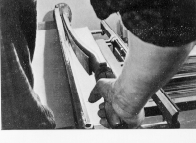 The strips are glued together with flour paste, wrapped around molds of different shapes, pressed together, and placed in a drying room.
The strips are glued together with flour paste, wrapped around molds of different shapes, pressed together, and placed in a drying room.
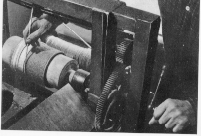
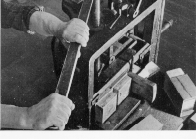 Next, the strips are steeped in a hot linseed oil bath, and dried again in an airtight oven.
Next, the strips are steeped in a hot linseed oil bath, and dried again in an airtight oven.
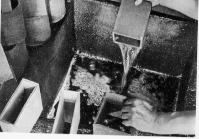
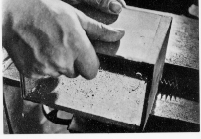 This treatment gives the pieces the hardness and strength of wood. It also makes them resistant to changes in weather and climatic conditions. Paper-mache (or papier-mâché, as it is written in French) is able to stand the test of time; witnessed by the many museum exhibits of boxes and even furniture. The material neither warps or cracks.
This treatment gives the pieces the hardness and strength of wood. It also makes them resistant to changes in weather and climatic conditions. Paper-mache (or papier-mâché, as it is written in French) is able to stand the test of time; witnessed by the many museum exhibits of boxes and even furniture. The material neither warps or cracks.
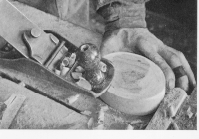
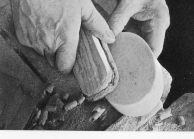 Once out of the oven, the pieces are sliced with a saw, planed and sanded before being assembled into a box of the desired size and shape and fit, if appropriate, with a top and bottom.
Once out of the oven, the pieces are sliced with a saw, planed and sanded before being assembled into a box of the desired size and shape and fit, if appropriate, with a top and bottom.
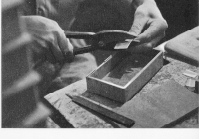
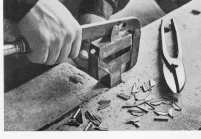 Handmade hinges are added to some boxes. The box is then primed with paint made of clay, drying oil, and soot.
Handmade hinges are added to some boxes. The box is then primed with paint made of clay, drying oil, and soot.
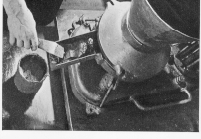
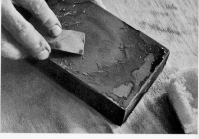 The primed pieces are dried and covered several times with natural black and clear lacquer on the outside,
The primed pieces are dried and covered several times with natural black and clear lacquer on the outside,
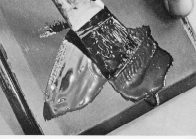
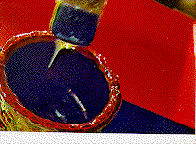 and red lacquer on the inside. All this preliminary work takes about a month and a half for a simply shaped box and can take as much as six months for a complex box.
and red lacquer on the inside. All this preliminary work takes about a month and a half for a simply shaped box and can take as much as six months for a complex box.
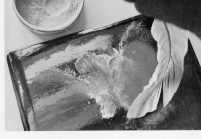
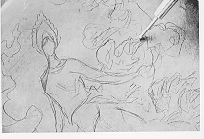 When the artist is ready to start painting the scene, he or she rubs the surface of the box with pumice-stone to create a surface to which the paints will adhere. The powdered stone is then brushed away with a goose feather. Then the artist usually makes a rough drawing on the surface with a blunt iron needle.
When the artist is ready to start painting the scene, he or she rubs the surface of the box with pumice-stone to create a surface to which the paints will adhere. The powdered stone is then brushed away with a goose feather. Then the artist usually makes a rough drawing on the surface with a blunt iron needle.
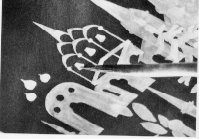
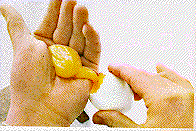 If the drawing is satisfactory, the artist sets to work with tempera, usually first with white zinc and then colored pigments. Every artist begins his working day with the preparation of egg tempera. Eggs are bought preferably from neighbors with free-range chickens. Eggs from large poultry farms are considered less suitable. The white and yolk are separated,
If the drawing is satisfactory, the artist sets to work with tempera, usually first with white zinc and then colored pigments. Every artist begins his working day with the preparation of egg tempera. Eggs are bought preferably from neighbors with free-range chickens. Eggs from large poultry farms are considered less suitable. The white and yolk are separated,
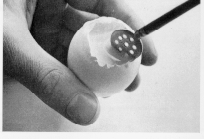
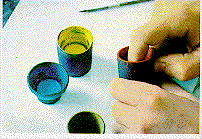 the latter is put back into the eggshell, vinegar is added, and then the contents are mixed with dry pigment and rubbed together by finger.
All the pigments are natural and will never fade regardless of exposure to direct sunlight. Sources for pigment are (a) earth or mineral, such as yellow ochre, and lapis lazuli; (b) animal, such as carmine and crimson lake (made from the dyestuff of the cochineal beetle); and (c) vegetable, such as rose madder (made from the roots of a plant).
the latter is put back into the eggshell, vinegar is added, and then the contents are mixed with dry pigment and rubbed together by finger.
All the pigments are natural and will never fade regardless of exposure to direct sunlight. Sources for pigment are (a) earth or mineral, such as yellow ochre, and lapis lazuli; (b) animal, such as carmine and crimson lake (made from the dyestuff of the cochineal beetle); and (c) vegetable, such as rose madder (made from the roots of a plant).
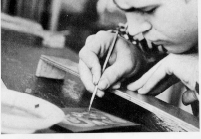
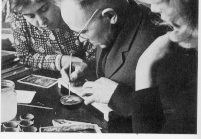 The artist uses squirrel-hair brushes for painting. Very often these brushes are made by the artist himself and can be as fine as a single hair. The colors are applied in a strict sequence that dates back to the origins of icon painting.
The artist uses squirrel-hair brushes for painting. Very often these brushes are made by the artist himself and can be as fine as a single hair. The colors are applied in a strict sequence that dates back to the origins of icon painting.
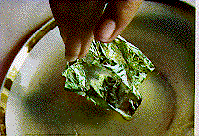
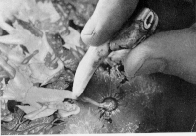 After painting and varnishing, the gold is applied. A very fine gold leaf is carefully rubbed into gum arabic by finger. Again a squirrel-hair brush is used to apply gold to the painting and on the sides of the box. To give the gold a burnished sheen, the artist polishes it with a wolf's tooth, which has a remarkably smooth surface.
After painting and varnishing, the gold is applied. A very fine gold leaf is carefully rubbed into gum arabic by finger. Again a squirrel-hair brush is used to apply gold to the painting and on the sides of the box. To give the gold a burnished sheen, the artist polishes it with a wolf's tooth, which has a remarkably smooth surface.
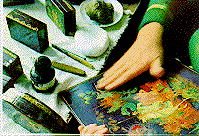 Finally the artist signs their name, the name of their village, and the year the box is finished on the top. Several final coats of varnish are applied and then the box is polished. Polishing begins on a velvet-covered wheel and ends after many hours of hand polishing with a fine cloth. From warm and loving hands, a papier-mache box enters the world of museums, private collectors and connoisseurs of beautiful things.
Finally the artist signs their name, the name of their village, and the year the box is finished on the top. Several final coats of varnish are applied and then the box is polished. Polishing begins on a velvet-covered wheel and ends after many hours of hand polishing with a fine cloth. From warm and loving hands, a papier-mache box enters the world of museums, private collectors and connoisseurs of beautiful things.
|
|

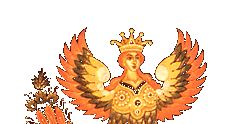


 The strips are glued together with flour paste, wrapped around molds of different shapes, pressed together, and placed in a drying room.
The strips are glued together with flour paste, wrapped around molds of different shapes, pressed together, and placed in a drying room.

 Next, the strips are steeped in a hot linseed oil bath, and dried again in an airtight oven.
Next, the strips are steeped in a hot linseed oil bath, and dried again in an airtight oven.

 This treatment gives the pieces the hardness and strength of wood. It also makes them resistant to changes in weather and climatic conditions. Paper-mache (or papier-mâché, as it is written in French) is able to stand the test of time; witnessed by the many museum exhibits of boxes and even furniture. The material neither warps or cracks.
This treatment gives the pieces the hardness and strength of wood. It also makes them resistant to changes in weather and climatic conditions. Paper-mache (or papier-mâché, as it is written in French) is able to stand the test of time; witnessed by the many museum exhibits of boxes and even furniture. The material neither warps or cracks.

 Once out of the oven, the pieces are sliced with a saw, planed and sanded before being assembled into a box of the desired size and shape and fit, if appropriate, with a top and bottom.
Once out of the oven, the pieces are sliced with a saw, planed and sanded before being assembled into a box of the desired size and shape and fit, if appropriate, with a top and bottom.

 Handmade hinges are added to some boxes. The box is then primed with paint made of clay, drying oil, and soot.
Handmade hinges are added to some boxes. The box is then primed with paint made of clay, drying oil, and soot.

 The primed pieces are dried and covered several times with natural black and clear lacquer on the outside,
The primed pieces are dried and covered several times with natural black and clear lacquer on the outside,

 and red lacquer on the inside. All this preliminary work takes about a month and a half for a simply shaped box and can take as much as six months for a complex box.
and red lacquer on the inside. All this preliminary work takes about a month and a half for a simply shaped box and can take as much as six months for a complex box.

 When the artist is ready to start painting the scene, he or she rubs the surface of the box with pumice-stone to create a surface to which the paints will adhere. The powdered stone is then brushed away with a goose feather. Then the artist usually makes a rough drawing on the surface with a blunt iron needle.
When the artist is ready to start painting the scene, he or she rubs the surface of the box with pumice-stone to create a surface to which the paints will adhere. The powdered stone is then brushed away with a goose feather. Then the artist usually makes a rough drawing on the surface with a blunt iron needle.

 If the drawing is satisfactory, the artist sets to work with tempera, usually first with white zinc and then colored pigments. Every artist begins his working day with the preparation of egg tempera. Eggs are bought preferably from neighbors with free-range chickens. Eggs from large poultry farms are considered less suitable. The white and yolk are separated,
If the drawing is satisfactory, the artist sets to work with tempera, usually first with white zinc and then colored pigments. Every artist begins his working day with the preparation of egg tempera. Eggs are bought preferably from neighbors with free-range chickens. Eggs from large poultry farms are considered less suitable. The white and yolk are separated,

 the latter is put back into the eggshell, vinegar is added, and then the contents are mixed with dry pigment and rubbed together by finger.
All the pigments are natural and will never fade regardless of exposure to direct sunlight. Sources for pigment are (a) earth or mineral, such as yellow ochre, and lapis lazuli; (b) animal, such as carmine and crimson lake (made from the dyestuff of the cochineal beetle); and (c) vegetable, such as rose madder (made from the roots of a plant).
the latter is put back into the eggshell, vinegar is added, and then the contents are mixed with dry pigment and rubbed together by finger.
All the pigments are natural and will never fade regardless of exposure to direct sunlight. Sources for pigment are (a) earth or mineral, such as yellow ochre, and lapis lazuli; (b) animal, such as carmine and crimson lake (made from the dyestuff of the cochineal beetle); and (c) vegetable, such as rose madder (made from the roots of a plant).

 The artist uses squirrel-hair brushes for painting. Very often these brushes are made by the artist himself and can be as fine as a single hair. The colors are applied in a strict sequence that dates back to the origins of icon painting.
The artist uses squirrel-hair brushes for painting. Very often these brushes are made by the artist himself and can be as fine as a single hair. The colors are applied in a strict sequence that dates back to the origins of icon painting.

 After painting and varnishing, the gold is applied. A very fine gold leaf is carefully rubbed into gum arabic by finger. Again a squirrel-hair brush is used to apply gold to the painting and on the sides of the box. To give the gold a burnished sheen, the artist polishes it with a wolf's tooth, which has a remarkably smooth surface.
After painting and varnishing, the gold is applied. A very fine gold leaf is carefully rubbed into gum arabic by finger. Again a squirrel-hair brush is used to apply gold to the painting and on the sides of the box. To give the gold a burnished sheen, the artist polishes it with a wolf's tooth, which has a remarkably smooth surface.
 Finally the artist signs their name, the name of their village, and the year the box is finished on the top. Several final coats of varnish are applied and then the box is polished. Polishing begins on a velvet-covered wheel and ends after many hours of hand polishing with a fine cloth. From warm and loving hands, a papier-mache box enters the world of museums, private collectors and connoisseurs of beautiful things.
Finally the artist signs their name, the name of their village, and the year the box is finished on the top. Several final coats of varnish are applied and then the box is polished. Polishing begins on a velvet-covered wheel and ends after many hours of hand polishing with a fine cloth. From warm and loving hands, a papier-mache box enters the world of museums, private collectors and connoisseurs of beautiful things.